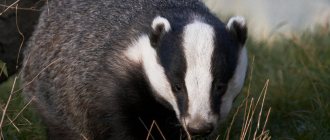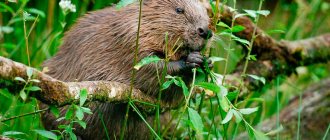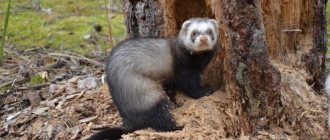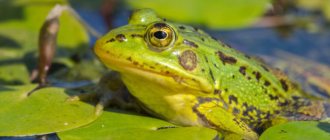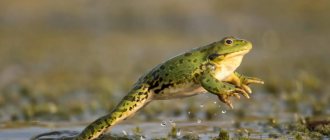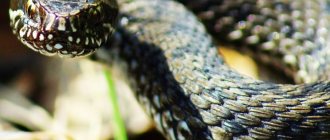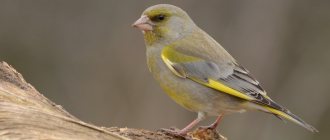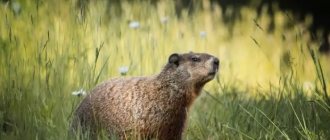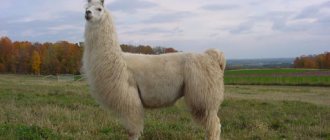7880
7881
7882
7883
7884
7885
7886
7887
7888
7889
7890
10951
10952
10953
10954
10955
10956
10957
Description
— Advertising —
The smallest species (Menzbier's marmot, wood marmot) weigh at least 2-3 kg, their body length is 35-40 cm, the largest (steppe, Himalayan marmots) reach 8-10 kg in weight and 65-70 cm in length. The physique of marmots resembles squirrels and gophers. Their body is ridged and their legs are short. The head is flattened, the eyes are widely spaced, sometimes slightly slanted. The nose is large. The ears are short and round in shape. The tail is short and rounded. The fur is thick and long, with sparse guard hairs and soft undercoat. The color is plain or with a contrasting belly, cheeks and head. The coat ranges from yellowish-gray, silver-gray, brown, reddish-red to black.
What does it eat?
Marmots are herbivores and feed on green parts of plants. They look for food both on the ground and in trees. The composition of feed varies with seasons and habitats of species.
The diet of marmots includes leaves and flowers, forbs, and grain crops. Sometimes marmots eat snails, beetles, and grasshoppers. In early spring they feed on the bark, buds and shoots of apple, dogwood, bird cherry, peach, and red mulberry. Their favorite food is alfalfa and clover. Marmots also eat garden crops such as peas and beans. The diet in captivity consists of wild lettuce, clover, bluegrass and sweet clover. An adult marmot eats about 700 g of food per day. These animals do not stockpile food.
Valuable fishery
In addition to being very funny and interesting, the marmot (baibak) is also a very valuable game animal. The skin of these animals well imitates the appearance of expensive furs, and therefore is in great demand. During international fur auctions, marmot skins are sold out quickly, and at a considerable price. A bobak fur coat will be a wonderful gift for a woman. When catching an animal, it is very important not to spoil its skin.
In addition, from one adult animal you can get about 2 kg of tender meat and about 1 kg of valuable fat. This is also why the steppe marmot (baibak) is highly valued. The fat of this animal, obtained in the autumn, is used not only for technical purposes, but is also widely consumed as a high-calorie food product. In addition, it is a proven medicine in the fight against tuberculosis and anemia. Marmot fat is also very effective for various traumatic injuries.
Common types of marmot
Gray marmot (Marmota baibacina)
The body length reaches 65 cm, the tail is about 13 cm long. Outwardly it resembles the boibak and tarbagan, but its fur is longer and softer, colored sandy-yellow, with black-brown hairs on the back, the belly is dark, reddish, and the head is dark "cap". The tail is colored on top in the same way as the back, and dark on the bottom.
The species is found in the Tien Shan and Altai mountains.
Baibak (Marmota bobak)
Body length is from 50 to 70 cm, maximum weight reaches 10 kg. The body is thick, the legs are short and strong with large claws. The head is large, flat, and the neck is short. The tail is short. The color is sandy yellow. The guard hairs have dark tips, which makes the back appear covered with dark brown or black ripples. The cheeks are light reddish in color, with brown or black streaks under the eyes. The belly is darker and redder towards the sides, the tip of the tail is dark brown. Molting occurs once a year.
Previously, boibak was found widely in the steppe and forest-steppe zones from Hungary to the Irtysh, but due to the plowing of virgin lands it disappeared almost everywhere, only populations survived on the Don, in the Middle Volga region, the southern Urals, in eastern Ukraine and Kazakhstan.
Gray marmot (Marmota caligata)
A large marmot with short legs and a wide head. The body length is 62-82 cm, with a tail length of 17 to 25 cm. Males are larger than females. Weight throughout the year ranges from 3.75 kg in May to 7 kg in September. The fur on the back and shoulders is silver-gray. The head is black on top with a white spot on the muzzle, on the chin and a white stripe around the lips. The legs are black below, occasionally with white spots. The belly is gray. The tail is long and covered with thick fur.
It lives in Canada and the USA, where it is found in treeless alpine meadows.
Black-capped marmot (Marmota camtschatica)
There are three subspecies: North Baikal, Leno-Kolyma and Kamchatka. Outwardly, they are similar to the Mongolian marmot tarbagan. They got their name because of their uniform brown color with a dark spot on the head, which from a distance looks like a cap.
The habitat includes Eastern and Northwestern Siberia.
Yellow-bellied marmot (Marmota flaviventris)
The body length of males is from 49 to 70 cm, in females from 47 to 67 cm. The weight of males is 3-5 kg, females 1.5-4 kg. The fur is gray-brown on the back and yellow-brown on the belly.
The species is distributed in the western USA and Canada, in the Sierra Nevada and the Rocky Mountains, at altitudes up to 2,000 m.
Himalayan marmot (Marmota himalayana)
It is dark chocolate brown with bright yellow spots on the face and chest.
It is found in the Deosai plains of Pakistan and Ladakh in Kashmir, at altitudes up to 3000 m.
Alpine marmot (Marmota marmota)
The body length is 40-50 cm, the tail length is 10-20 cm. Weight is about 3 kg. Males are usually larger than females. The head is blackish-gray, the muzzle is light. The ears are small and pubescent. The back is gray, light brown or red, the belly is yellowish.
The species lives in the Alps, Carpathians and High Tatras, on rocky slopes at altitudes from 600 to 3200 m.
Menzbier's marmot (Marmota menzbieri)
The smallest type. Body length is 40-45 cm, average weight reaches 2.5 kg. The distribution area is the western Tien Shan.
Woodchuck (Marmota monax)
Body length is from 42 to 67 cm, weight is 3-5 kg. Males are larger than females. The body is dense, the legs are short and strong. The tail is short, flat, bushy, black or dark brown. The ears are small and round in shape. The color is reddish or reddish-brown with a gray coating. There is a white spot near the nose. The belly is light. Paws are black.
A widespread species in the northeast and central states of the United States, central Alaska, and the Labrador Peninsula.
Mongolian marmot (Marmota sibirica)
Body length is about 60 cm. The species lives in Russia (in the steppes of Transbaikalia and Tuva), Mongolia (except for the southern regions), and in northeast China.
Olympic marmot (Marmota olympus)
A large species, the body weight of which reaches 7 kg.
Endemic to the Olympic Mountains, located in western Washington state in the northwestern United States.
Vancouver Marmot (Marmota vancouverensis)
Body length is 68-70 cm. Weight varies throughout the year from 3-3.5 kg to 5-6 kg. The fur also changes color with the seasons. At the beginning of summer it is brown, in July it moults and becomes black with white stripes.
Endemic to Vancouver Island in Canada, where it lives in mountains about 1.5 km high. An endangered species.
General Features
An increase in the number of bobak today is observed in the Voronezh, Rostov, Orenburg, Chelyabinsk, Samara, Ulyanovsk and Saratov regions, as well as in Bashkiria, Tatarstan and Chuvashia, beyond the Urals and in Northern Kazakhstan. In those regions where the marmot population is still low, it is listed in the Red Book.
Differences in terrain have a great influence on the very structure of marmots and their life. It happens that boars in one territory are much larger than in another. The marmot is usually about 65 cm long and weighs from 7 to 16 kg. There are also especially large specimens of fattened males, but the meat of such a giant is quite tough.
These animals don't need much space. The summer life of the bobak is very short. At night, marmots stay in their burrows and do not come out. At dawn, first the adult individuals emerge from the hole: they carefully stick out their muzzles, look out, listen, and, making sure that there is no danger for them, decide to leave the shelter. At first they sneak quietly, then they completely crawl out of the hole, look around and begin to eat the grass if they do not see danger.
Where there are huge colonies of marmots and nearby farmland, then the farmer’s fields suffer significant damage. He especially liked sunflower crops, for example in the Rostov region.
Marmots avoid extreme heat because they quickly die from overheating. Having eaten their fill, marmots sometimes go to bed with the whole family to rest and often spend several hours basking in the sun. They play funny games with each other, hug and even kiss.
The whole problem for the groundhog is that he runs quietly, so he is not able to get away from danger. This is what makes the groundhog so cautious and timid. In those places where they are rarely hunted, marmots are so bold that they lie on the butanes even when danger seems to be very close.
Marmot_Stéphane [email protected]
Groundhog behavior
Marmots build burrows in dry areas that are well heated by the sun. Winter burrows are found in forests, summer burrows are found in open, flat areas, for example, in fields. Groundhog burrows have from 1 to 11 exits. The total length of the tunnels reaches 15 m. In a permanent burrow, the tunnels lead to the nesting chamber, which is lined with dry leaves and grass. Marmots also build special toilet chambers.
Marmots lead a solitary, sedentary lifestyle, only during the breeding season they live in pairs or groups. The period of activity of the groundhog is day, occasionally twilight and night.
By autumn, marmots eat off and accumulate fat. To hibernate, they migrate to wooded areas. Hibernation lasts from October to March-April. During thaws they may wake up briefly. During hibernation, metabolic processes decrease, the number of heartbeats is 10-15 beats per minute, body temperature is about 8 ° C, and the breathing rate decreases.
Marmots communicate with each other using a characteristic piercing whistle, heard at a distance of 200-300 m. While on the surface of the earth, they take a posture in a column. When threatened, they hide in a hole and move at speeds of up to 3 km/h.
Habitat, lifestyle and habits
Boibaks live in large, perennial colonies, making burrows of various purposes and complexity for housing. Their temporary burrows are small, short, with one entrance, without a nesting chamber; Marmots hide in them from danger and occasionally spend the night. The marmot has up to 10 such burrows within its feeding area. Permanent burrows are more complex and can be winter or summer. Summer (brood) burrows are a complex system of passages; they are connected to the surface by several (up to 6-15) exits. A series of holes or dead ends branch off from the main passage of the burrow, in which marmots build latrines. At a depth of 2-3 m there is a nesting chamber with a volume of up to 0.5-0.8 m³, into which the marmot drags dry grass and roots. Winter (wintering) burrows can be simpler, but the nesting chambers in them are located deeper, in non-freezing soil horizons - up to 5-7 m from the surface. The total length of the passages and burrows of a permanent burrow reaches 57-63 m. In particularly complex burrows there are several chambers of different sizes, and the passages form several floors. When constructing a permanent burrow, up to ten cubic meters of soil are thrown onto the surface, forming a marmot hill. Usually, marmot stands out sharply against the background of steppe chernozem with a lighter color; The soil here is drier, saturated with nitrogen and minerals from marmot droppings. The height of the hill reaches 40-100 cm with a diameter of 3-10 m. On the marmot, near the inhabited burrow, there is a trampled area from where marmots inspect the surroundings. The rest of the marmot is gradually covered with vegetation that is very different from the surrounding flora: wormwood, wheatgrass, and kermek grow here. In places densely populated by marmots, up to 10% of the surface is covered with marmots, which is why the landscape takes on a peculiar wavy character.
Marmot Reproduction
Males emerge from hibernation first, and from the beginning of March to the end of April they search for females and engage in skirmishes with each other. Pregnancy lasts 31-32 days. The female brings from 2 to 7 cubs once a year. Babies are born in April-May, naked, deaf and blind, with a body weight of about 27 g and a length of up to 10 cm. In the second week of life, short black hair appears on the body. Milk feeding lasts about 44 days. Males do not breed offspring. At the age of 6-7 weeks, young marmots begin to disperse. They reach sexual maturity after the first hibernation.
The life expectancy of marmots in the wild is 4-6 years, in captivity up to 10 years.
Birth of a new generation
In the second half of spring, and marmots awaken from hibernation at the beginning, the mating season begins (sometimes it begins right in the burrows). And in May-June, the female gives birth to five (plus or minus one) marmots, which are naked like kittens and weigh less than forty grams.
Feeding with mother's milk occurs until the end of summer, after which the young are ready to explore the world on their own.
They will become sexually mature no earlier than four years later (the longest period for rodents) and if they are lucky, they will live one or even two decades.
Natural enemies
Marmots are hunted by wolves, pumas, lynxes, bears, mustelids, large birds of prey and snakes. In agricultural areas, large predators are rare, and marmots' main predators include foxes, coyotes, and dogs.
Marmot holes become a haven for many species of animals, snakes and birds; they are occupied by otters, chipmunks, gray voles, shrews, house mice, jerboas and white-footed hamsters. A rabbit, opossum, raccoon and skunk can easily spend the winter in the same burrow as a sleeping groundhog. Foxes also dig up and occupy marmot burrows.
Interesting facts about the rodent:
- In the United States, Alaska has celebrated Groundhog Day on February 2 since 1886. On this day, according to the behavior of the groundhog, the duration of winter and the proximity of the arrival of spring are determined.
- Monuments to the marmot were erected in Angarsk, Aznakaevo and Karaganda.
- The Mongolian marmot is a carrier of the plague pathogen. In ancient times, it was consumed as food by the nomadic peoples of Central Asia, the Huns and the Mongols.
Weapon Selection
The origin of the weapon does not matter: accuracy and reasonable price are important here. Each barrel has its pros and cons.
Imports are good in terms of external finishing and mechanical quality, but the manufacturer skimps on the materials used. Therefore, domestic weapons may not be cleaned for quite a long time, and nothing will be done to them, which cannot be said about imported modern products, which increasingly look like souvenirs. Therefore, if you come across a domestic, high-quality rifle or carbine, it’s enough to shoot it and enjoy your luck in the hunt.
It is best to target one type of cartridge from one batch and always be confident in your trajectory. By the way, persistently cleaning after every hunt is not always correct, because accuracy is higher with weapons that have already been fired a little (about a dozen shots, no more).
You should like the weapon. Your rifle is the best. I think you should shoot from a working rifle, and not fiddle with it.
